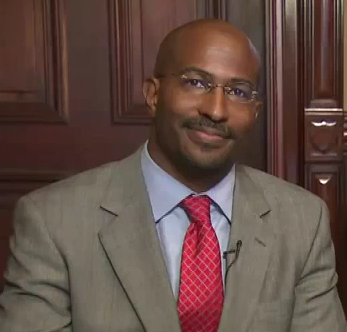 |
| Van Jones |
Thomas Jefferson’s promise of a new government “deriving just powers from the consent of the governed” under the premise that “all men are created equal,” seems to have fallen short. After years of recession and rampant unemployment followed by waves of right-wing austerity and xenophobia, the Dream, to some, needs rebuilding.
Enter Van Jones, hailed by liberals as a charismatic leader and despised by the right as a crypto-communist. Together with MoveOn.org, Jones has launched a movement titled “Rebuild the Dream,” with which he hopes to reinvigorate the progressive movement in America. The movement started with several thousand house parties, one of which I attended on July 17 in Jackson, California. The meeting consisted of around 24 people from the “red” counties of the Sierra foothills, a rural region that for the past thirty years has voted consistently Republican. Nora Coryell, the host of the event, states:
“That two dozen people from four counties showed up to participate in our meeting showed that there is a good deal of interest in this movement in the foothills. In fact, the signups exceeded the limit I'd set and were closed off the week before. There were some impressive people there. Apparently, there was a fairly large group that also met in Sonora the next day. Here we were able to complete the assignment on time, and are told that the results of the more than 25,000 participants around the country are being processed and will be utilized and distributed in August and more meetings are being planned for September.”Among the items discussed, a cut in defense spending, the implementation of a “Medicare for All” healthcare system, and the repealing of corporate personhood were the most popular. The attendees were most concerned about the weakening of American democracy, and discussed how to make governmental institutions more accountable to the public and less bound to the interests of large corporations. The American Dream, it seems, is not just about ensuring prosperity but also about ensuring that the public has control over the political decisions that affect our daily lives.
If this is the case, the American Dream is not dead, but only because a dream must first live in order to die. The dominance of the wealthy elite in the sphere of government is not a recent phenomenon, nor does it defy the structure of government developed by the Federalist framers of our Constitution. Alexander Hamilton, the first Secretary of the Treasury, sums up the elitism of his day during the Constitutional Convention:
“All communities divide themselves into the few and the many. The first are the rich and well born, the other the mass of the people…The people are turbulent and changing; they seldom judge or determine right. Give therefore to the first class a distinct, permanent share in the government. They will check the unsteadiness of the Second...Can a democratic assembly who annually revolve in the mass of the people, be supposed steadily to pursue the public good? Nothing but a permanent body can check the imprudence of democracy.”Perhaps most indicative of the builders of the American Dream’s contempt for the public and not so suble authoritarianism comes from none other than George Washington, who, in a letter to John Jay, described the problem of early American government:
Citizens of both the right and left complain that their representatives are anything but, yet nobody is comfortable with acknowledging that many of our Founders intended for just that. American democracy, and the freedom that it has provided, did not come from the hierarchical vision of our Founding Fathers but is rather the net result of two centuries worth of popular movements. The “anti-federalists,” populists, abolitionists, suffragists, socialists, unionists, and civil rights advocates all refused to accept the American Dream, and as a result, we live today in an era where all adults can vote, no human being is expected to live in servitude, and individuals have at least some legal protection from their government and employer.“We have probably had too good an opinion of human nature in forming our confederation. Experience has taught us, that men will not adopt & carry into execution, measures the best calculated for their own good without the intervention of a coercive power”
It all makes sense now...
Despite the success of the political left in American history, Rebuild the Dream is oddly billing itself as the left’s version of the modern Tea Party movement, as though giant demonstrations of sign holding radicals is a recent conservative invention. Van Jones explained,
“If we take a bold and courageous stand, over time, we can win. Make no mistake about it: this is our "Tea Party" moment -- in a positive sense.”Don’t let these criticisms belie the importance of a united progressive movement in America. The threat of rolling back the great reforms of the 20th century is very real, and only a well organized left can preserve what we have gained. Rebuild the Dream is the only movement truly attempting this, and it would be wise to both support and participate in it. At the same time, we should not forget the radical heritage of American progress, or that the founders set the American Dream on the principle that the public cannot govern themselves.
As the late comedian George Carlin succinctly stated:
"the owners of this country know the truth: It’s called the American Dream, because you have to be asleep to believe it.”Perhaps, to truly be rid of the power of the owners of this country, we must first wake up.
-------------------------------------------------------------------------
Coming Next Week: How the "Rebuilding the Dream" platform could change rural America.

No comments:
Post a Comment